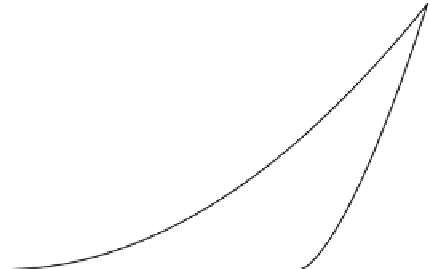Biomedical Engineering Reference
In-Depth Information
A
P
P
h
h
c
S
=
d
P
/d
h
C
B
0
h
r
h
c
h
FIGURE 17.1
Load-depth curves of an indentation test (a schematic).
P
—load,
h
—total depth of penetration,
h
c
—contact depth,
h
r
—residual depth after unloading,
S
—contact stiffness.
Dotted curve at the right—unloading curve typical of
viscoelastic materials.
17.2
BASIC INFORMATION FROM THE LOAD-DISPLACEMENT CURVES
17.2.1
Hardness and Elastic Modulus
Nanoindentation, called also instrumented indentation, provides information from the indenter load
and displacement. This can yield much more information than the common hardness tests based on
the observation of imprints, though observation always brings useful information. Most nanoindenta-
tion measurements use a simple load-unload cycle (
Figure 17.1
). The basic material characteristics
are hardness
H
and elastic modulus
E
, introduced in Section 16.2. Hardness in nanoindentation tests
is defined as the mean contact pressure
p
m
,
H
p
P A
/
(17.1)
m
P
is the nominal load and
A
is the projected contact area, determined from the contact depth
h
c
, which
can be calculated from the total penetration
h
, the indenter load and contact stiffness
S
at the begin-
ning of unloading as
[4]
:
h
h
ε
/
P S
(17.2)
c
where ε is a constant (ε
0.75 for a spherical or pointed indenter). The stiffness
S
(
d
P
/d
h
) is
obtained from the upper part of the unloading curve, usually fitted by regression function
[4]
:
(17.3)
m
P
k h
(
h
)
p
k
,
h
p
, and
m
are constants. Contact stiffness and area (see further) also serve for the determination of
the reduced (
sample
indenter) modulus
E
r
:
E
1 2
/
1 2
/
(17.4)
r
π
S
/(
2
β
A
)















